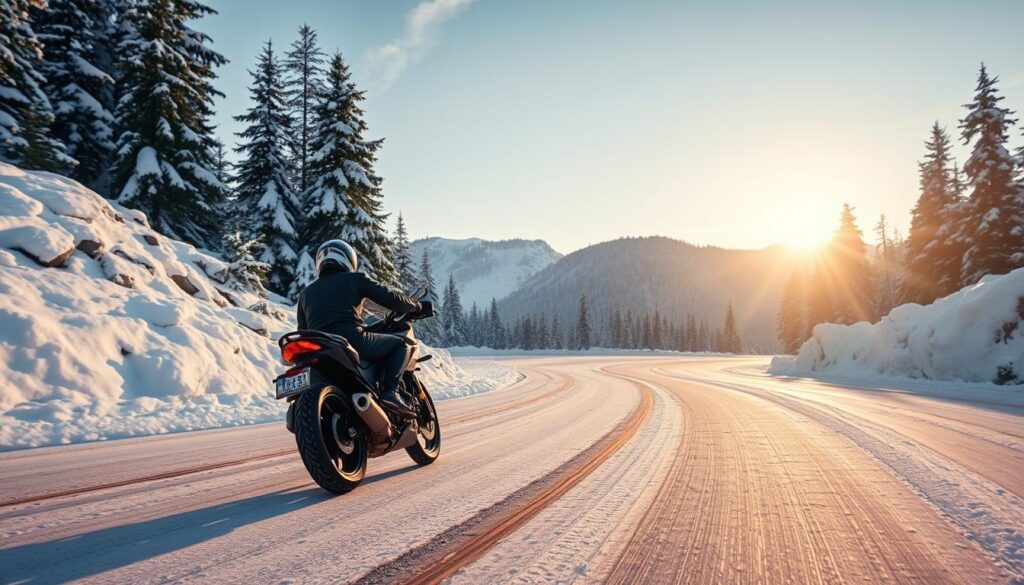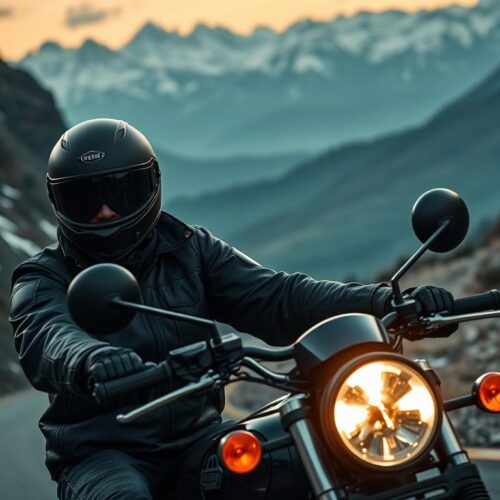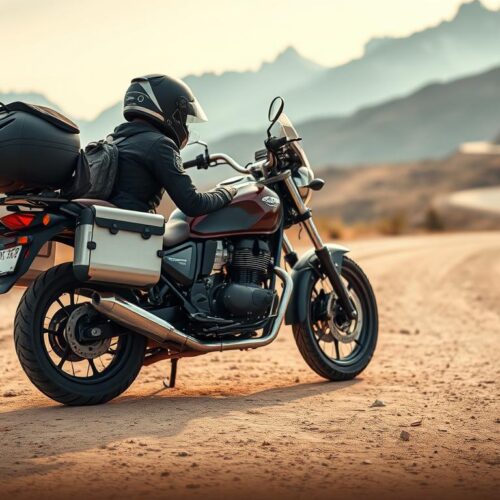Winter motorcycle riding presents unique challenges. But with the right gear and knowledge, it can be thrilling. You need to know the right gear and how to maintain your bike in the cold. With the right strategies and equipment, you’ll enjoy winter riding.
Understanding the Challenges of Winter Motorcycle Riding
Winter poses significant challenges for motorcycle riders, impacting their riding experience. Ice, snow, and sleet reduce traction and control. Even at 32°F, conditions become dangerous, especially with moisture that forms black ice.
When riding in cold weather, watch out for hidden ice patches. These can be invisible yet very dangerous. Cold tires also lose grip faster, so adapt your riding techniques accordingly. Roads may also have leaves and moss, creating slippery spots.
Knowing how winter affects your motorcycle’s grip is vital. It changes how you should accelerate, brake, and turn. An increased awareness of road conditions helps you ride safer in the cold. This ensures you stay in control, despite winter’s challenges.
Essential Gear for Winter Motorcycle Riding
Choosing the right winter motorcycle gear is key for comfort and safety during cold rides. A good winter jacket with a removable liner helps adjust to different temperatures. It’s important to wear a first layer made of moisture-wicking materials like merino wool.
After your base layer, add insulation layers to keep heat in without being too bulky. Finish your gear with heated gloves and waterproof outer shells for your hands and body. A heated vest can also add extra warmth to your core area.
Being seen is important in winter. Make sure your gear has features like anti-fog visors on helmets. Layering your clothes helps keep you warm and manages moisture, keeping you dry and comfortable.
Motorcycle Maintenance for Winter Conditions
Making sure your motorcycle is ready for winter is essential. It keeps you safe and ensures your bike performs well. Start by checking the tires. They should be right for cold weather. Because cold air makes tires lose air, you need to check their pressure often.
It’s important to have tires properly filled. This improves how your motorcycle handles and grips on icy roads.
Don’t forget to check the brakes. They must work well, especially on slippery roads, to avoid accidents. Also, think about using synthetic oils. They work better than regular oils in the cold.
Road salt is bad for your motorcycle. It can cause rust and damage. After riding, clean your bike well to get rid of salt and dirt. Keeping your motorcycle clean helps it last longer and stay in good shape during winter. Make sure all lights and signals are working. This is crucial for being seen in bad weather and when it gets dark early.

Thorough winter maintenance is key for a great riding experience in tough conditions. By preparing your bike well, you can ride safely and confidently all winter long.
Layering Techniques for Cold Weather
Layering right is key to staying comfy in cold weather. Start with a close-fitting base layer that moves sweat away. This keeps you dry and warm, avoiding the chill from sweating. Then, go for a fleece or down mid-layer to keep the cold out.
Your top layer should stop wind and water. Look for something like Gore-Tex to keep dry. It’s important for staying warm but still letting your skin breathe. Remember to add extras like neck tubes, balaclavas, and thermal gloves. They’re great for keeping your hands, neck, and head warm.
Staying Visible in Winter Conditions
Winter riding has a visibility problem that riders need to solve. This comes from darkness, rain, fog, and shiny surfaces. Wearing bright jackets and vests is a smart move. They help drivers see you better.
Using anti-fog visors with Pinlock inserts or other treatments helps keep your vision clear. This helps you see better and makes you more visible in winter conditions.
Think about making your motorcycle’s lights better, too. Switching to LED bulbs makes your lights brighter. This makes the road easier to see for you and makes others see you better. It lowers the chance of accidents.
Riding Techniques for Safe Control
Mastering winter riding skills is key for safety in the cold. Use the throttle and brakes gently to keep traction. Sudden moves can make your tires slip, raising the risk of an accident.
It’s important to shift your weight right during turns. This helps your tires grip better, making you more stable. Also, make sure to leave more space behind the car in front of you. Extra space gives you time to react to ice or snow on the road.
Staying relaxed helps you control the bike better. Feeling tense can make you jerk the bike, which is dangerous. With these tips, riding in winter becomes safer and more fun.

Preparing for Ice and Snow
When ice and snow hit, being ready is key for safe riding. First, choose the right tires. Studded or winter tires offer the best grip on icy roads. The gear you wear also greatly affects your ride in tough conditions.
Knowing your surroundings is important, too. Watch out for shaded spots, where ice could be hiding. Bridges and overpasses can get icy really fast, so be careful. Picking the right path can help you avoid dangers.
It’s crucial to spot early signs of sliding. Keep a light grip, so you can easily adjust if you start sliding. Using these tips will help you stay in control and confident when riding in the winter.
How to Deal with Winter Wind Chill
Riding in cold weather brings unique challenges. Wind chill can make it feel much colder. You should wear motorcycle jackets with thermal insulation and windproof materials. These jackets help fight off the cold wind during your rides.
Your choice of gloves is very important for comfort. Make sure they keep you warm and block the wind. Heated grips or handlebar covers, like Hippo Hands, add extra warmth. This lets you have better control in cold weather.
It’s crucial to know about wind patterns for your rides. Check the weather forecasts and plan your routes to avoid harsh wind chill. This step helps you make smart choices on when and where to safely ride.
- Choose thermal shells that fit well and block wind effectively.
- Wear layers that trap heat while still remaining breathable.
- Opt for neck gaiters or balaclavas to protect exposed skin.
- Regularly check your equipment for damage to maintain insulation quality.
With the right planning and gear, cold weather rides can be enjoyable. Just make sure to stay warm and safe as you explore.
Planning Your Winter Riding Routes
Planning your winter rides is key to staying safe and having fun. It’s important to pick routes that are clear and well-kept. Knowing what to expect from the winter weather can help choose your path. Talking to other riders or looking up info online will show you the best ways to go.
When you go matters too. Try to leave when it’s a bit warmer to avoid icy roads. Learning which places get slippery will help you steer clear of danger.
A good map or the Google Maps app can make finding your way easier, especially on quiet roads. Always check the weather before you head out to make plan changes if needed.
Winter Riding Events and Communities
Being part of a winter riding community makes riding in the cold better. Local clubs hold events for riders to meet and bond. At these events, you can chat, swap tips, and plan for winter rides.
Events for winter biking are fun and improve your skills. Whether it’s a short trip or a big rally, you get to try new riding tips. Plus, it’s exciting to ride in snow or ice with friends.
Online groups and forums also help winter riders. They offer advice, stories, and keep you eager to ride in the cold. Joining these groups gives you more knowledge and a bunch of friends to ride with during winter.




